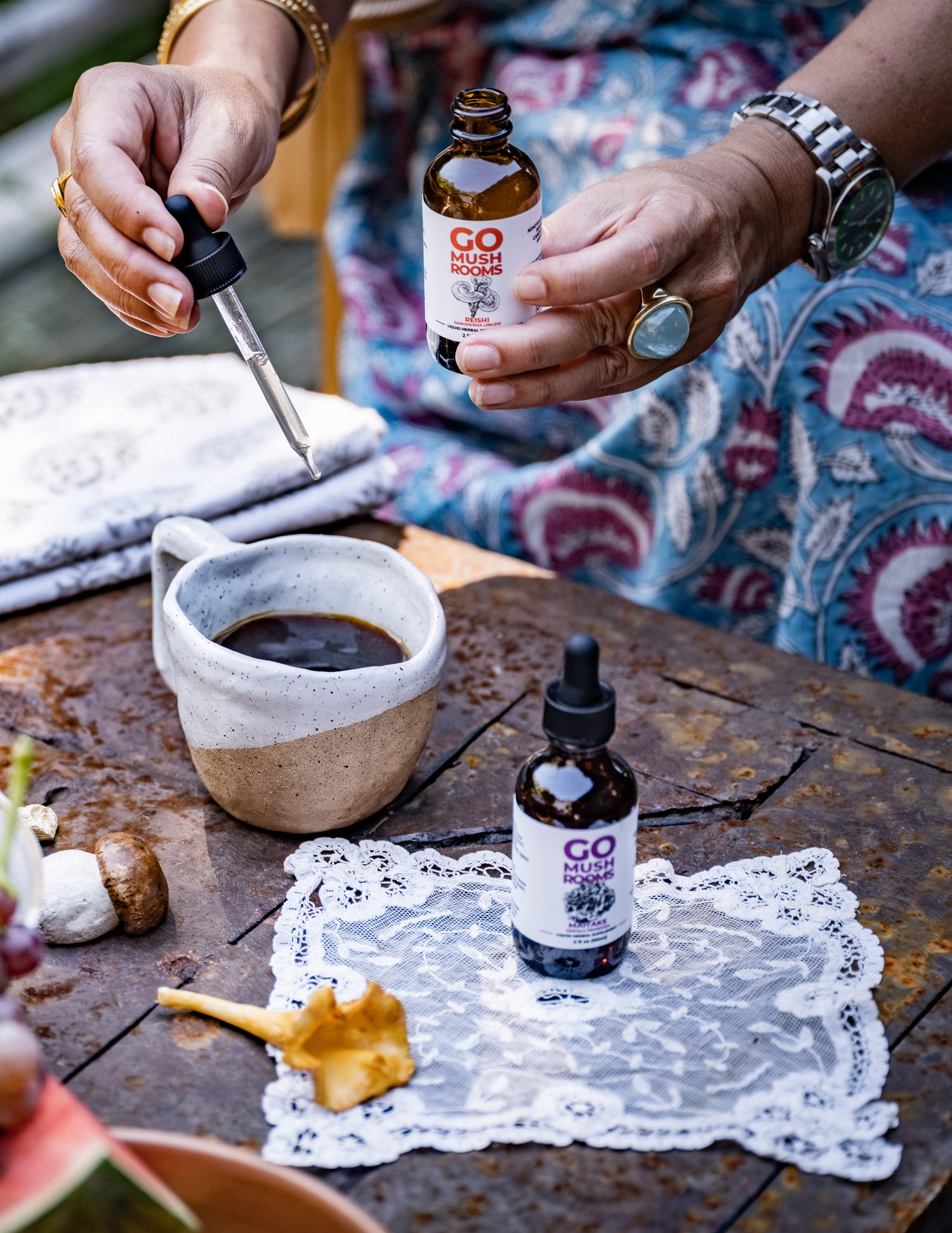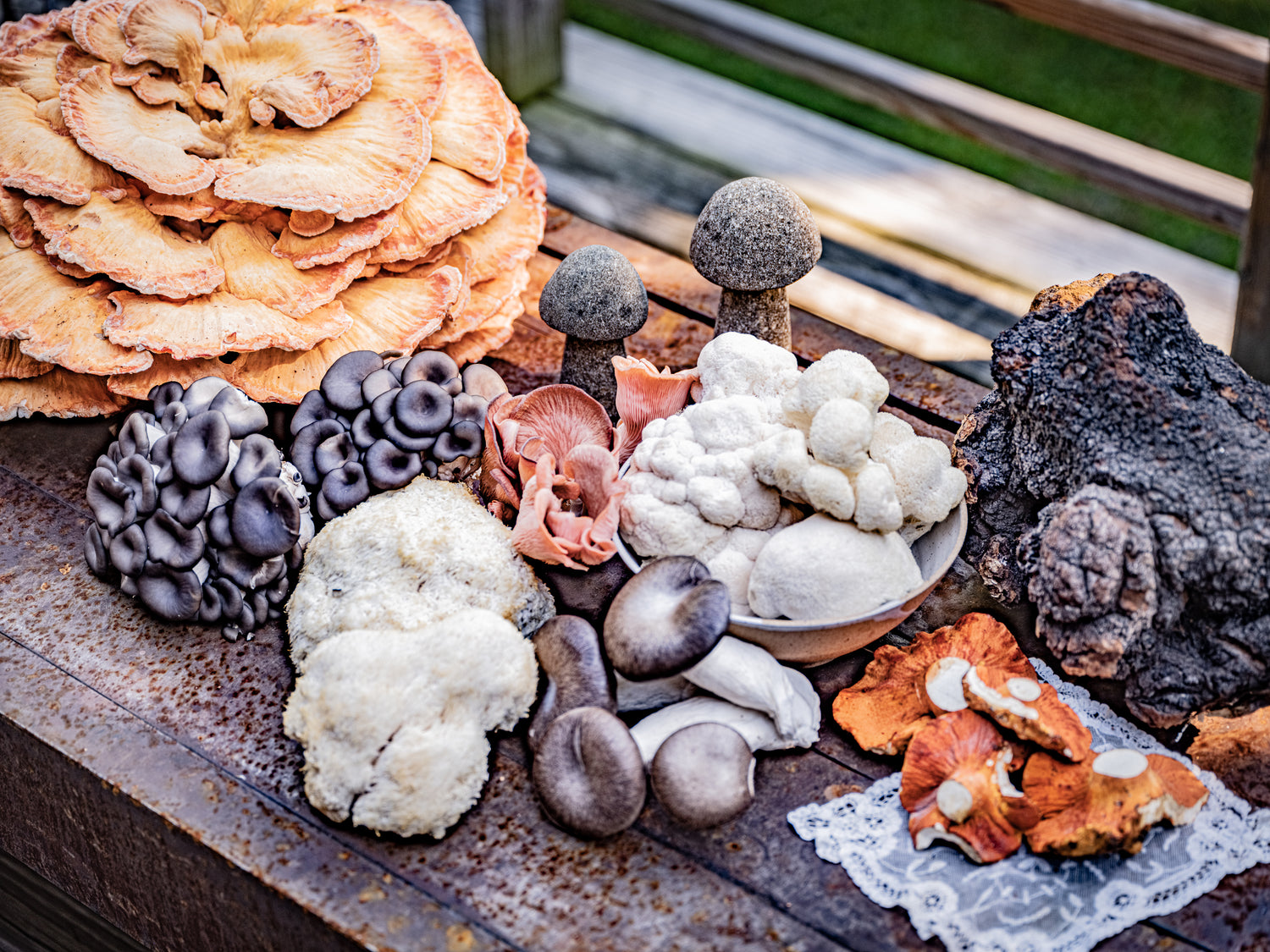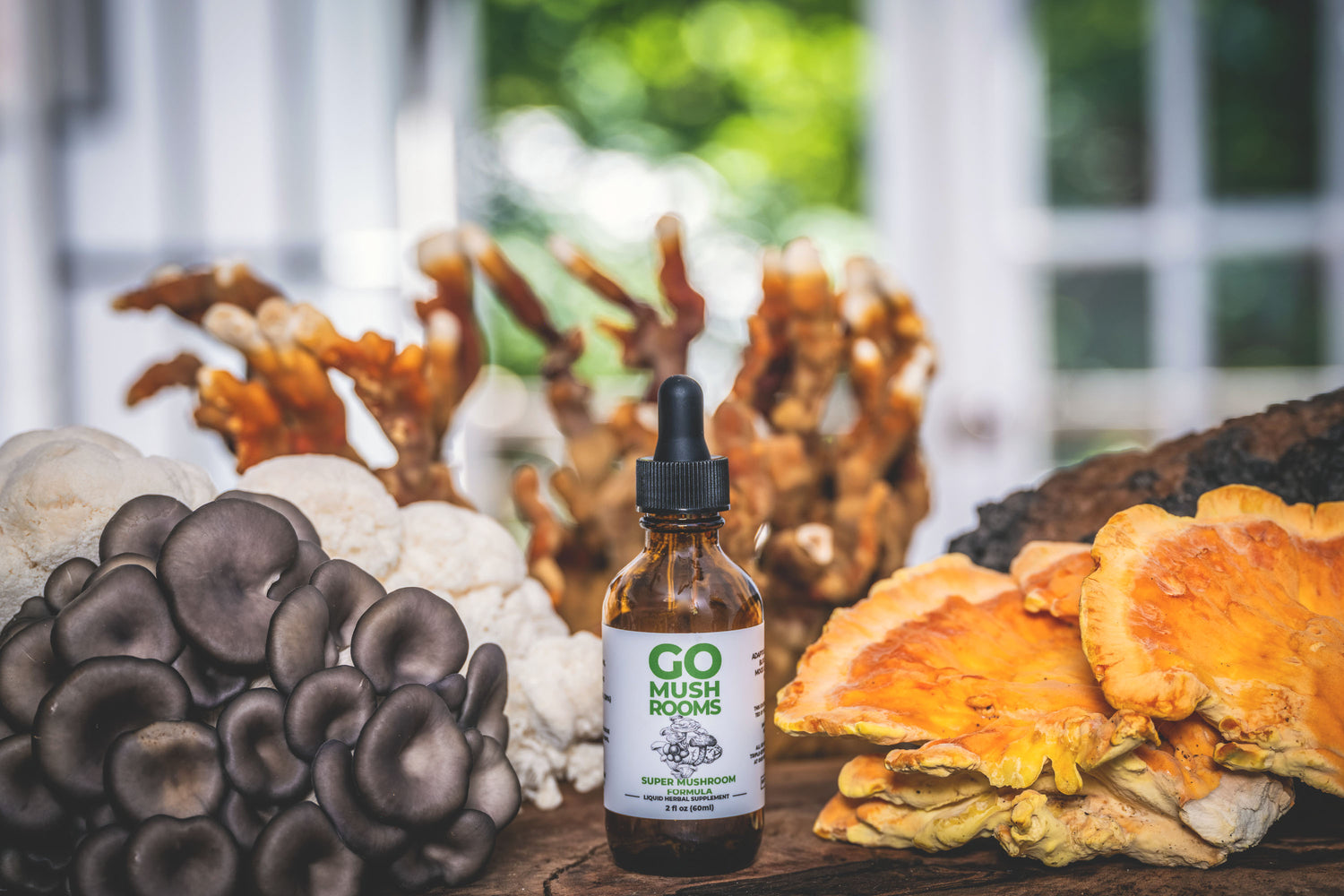
The Science Behind Medicinal Mushrooms
Did you know?
Medicinal Mushrooms contain a high density of polysaccharides, beta-glucans, and triterpenes. They also contain over one thousand other bioactive compounds such as phenols, sterols, and tannins. When extracted, a variety of these naturally occurring compounds in Medicinal Mushrooms have been suggested to support immune function, boost cognition, fight fatigue, improve mood and benefit a wide range of medical conditions. So what are these polysaccharides, beta-glucans and triterpenes? Medicinal Mushrooms are often referred to as adaptogens. What is an adaptogen?
Definitions
Adaptogens
Adaptogens are substances that help your body maintain homeostasis and respond to fatigue, anxiety, illness, or stress - in other words, they support the body's ability to adapt. Research suggests that in addition to exerting anti-fatigue, pro-cognitive, and immunomodulatory effects, adaptogens might also help play a role in balancing levels of our stress-inducing hormone, cortisol.
Medicinal Mushrooms are one of the few naturally-ocurring sources of adaptogenic compounds, and some Medicinal Mushrooms that have been used in healing for centuries such as Reishi (Ganoderma sp.), Chaga (Inonotus obliquus), Turkey Tail (Trametes versicolor), Lion's Mane (Hericium erinaceus),and Cordyceps (Cordyceps militaris)are now often referred to as 'adaptogenic mushrooms' for their supportive role in the body's natural regulation functions.
Beta-glucans
The cell walls of mushrooms boast a special type of adaptogenic polysaccharide known as beta-glucan. The basic role that beta-glucans play within the structure of mushroom cell walls seems to mirror the overall immunomodulatory effect that beta-glucans have on our bodies. These compounds are thought to have a meaningful beneficial impact on the immune system, as research suggests that beta-glucans effectively stimulate the host immune response to defend against bacterial, viral, fungal, or parasitic infection.
Polysaccharides
Polysaccharides are a complex carbohydrate and are one of the most commonly occurring bioactive adaptogenic compounds in fungi. Thought to play an immunomodulatory role while simultaneously boosting cognitive function and mood, specific types of mushrooms, like Reishi, Turkey Tail, and Maitake, all possess high levels of polysaccharides such as alpha- and beta-glucans. Along with many other bioactive compounds, a high level of beta-glucans is what characterizes our Medicinal Mushroom Tinctures.
Triterpenes
Commonly found in Reishi and Chaga, triterpenes are noted to have significant potential to support the human immune system. They are implicated in the mechanisms of action and pharmacological effects produced by many plants and fungi that are used in folk medicine against diseases. As well as being immunomodulator compounds, they have been described as anti-inflammatory, antiviral, and antimicrobial agents.

Why Tinctures?
Tinctures make enjoying the therapeutic benefits of Medicinal Mushrooms easy!
Because most Medicinal Mushroom bioactive compounds are water or alcohol-soluble but locked inside a matrix of chitin within the fruiting body, all of our Tinctures undergo an Ultrasonic and Soxhlet extraction process to break down the tough chitin walls of the mushroom and render the compounds bioavailable.
You cannot get these benefits from eating mushrooms or grinding them into a powder. Our extraction processes ensures high concentrations of immune-supporting triterpenes, mood-boosting beta-glucans, and other homeostasis-promoting adaptogens in all GO Mushrooms Tinctures.

Whole Fruiting Body vs. Mycelium?
There’s been controversy over the inclusion of the mycelium, which is the root structure of the mushrooms, as well as the whole fruiting body in Medicinal Mushroom products. The majority of the mushroom polysaccharides reported to have adaptogenic qualities are found in the whole fruiting body (the stem and the cap), so Medicinal Mushroom products made from just the body will naturally have higher levels of adaptogens. At GO Mushrooms, we use only the whole fruiting body, and not the mycelium and substrate in which the mushrooms are grown.

Medicinal Mushrooms are not a cure-all. But there is a growing body of evidence that suggests they can boost the body’s natural defense systems, help lower stress levels, and fight inflammation. If you want to get in tune with the mighty power of mushrooms, try our Medicinal Mushroom tinctures. Pick one or more, depending on the healing support you are looking for, or try our Super Mushroom formula which has been carefully curated from a combination of healing mushrooms.
Resource Library
Chaga
- Alhallaf, W., & Perkins, L. B. (2022). The Anti-Inflammatory Properties of Chaga Extracts Obtained by Different Extraction Methods against LPS-Induced RAW 264.7. Molecules (Basel, Switzerland), 27(13), 4207. https://doi.org/10.3390/molecules27134207
- Glamočlija J, Ćirić A, Nikolić M, Fernandes Â, Barros L, Calhelha RC, Ferreira ICFR, Soković M, van Griensven LJLD. Chemical characterization and biological activity of Chaga (Inonotus obliquus), a medicinal "mushroom.” Journal of ethnopharmacology. 2015; 62:323–332. https://pubmed.ncbi.nlm.nih.gov/25576897/
- Lu, Y., Jia, Y., Xue, Z., Li, N., Liu, J., & Chen, H. (2021). Recent Developments in Inonotus obliquus (Chaga mushroom) Polysaccharides: Isolation, Structural Characteristics, Biological Activities and Application. Polymers, 13(9), 1441. https://doi.org/10.3390/polym13091441
- Ning X, Luo Q, Li C, Ding Z, Pang J, Zhao C. Inhibitory effects of a polysaccharide extract from the Chaga medicinal mushroom, Inonotus obliquus (higher Basidiomycetes), on the proliferation of human neurogliocytoma cells. International journal of medicinal mushrooms. 2014; 16(1):29–36. https://pubmed.ncbi.nlm.nih.gov/24940902/. doi:10.1615/intjmedmushr.v16.i1.30
Lion's Mane
- Kushairi N, Phan CW, Sabaratnam V, David P, Naidu M. Lion’s mane mushroom, Hericium erinaceus (bull.: Fr.) pers. Suppresses H2O2-induced oxidative damage and LPS-induced inflammation in HT22 hippocampal neurons and BV2 microglia. Antioxidants (Basel, Switzerland). 2019;8(8):261. https://www.mdpi.com/2076-3921/8/8/261/htm
- Spelman K, Sutherland E, Bagade A. Neurological Activity of Lion’s Mane (Hericium erinaceus). Journal of Restorative Medicine. 2017;6:19-26. doi: 10.14200/jrm.2017.6.0108
- Szućko-Kociuba I, Trzeciak-Ryczek A, Kupnicka P, Chlubek D. Neurotrophic and Neuroprotective Effects of Hericium erinaceus. International Journal of Molecular Sciences. 2023; 24(21):15960. https://doi.org/10.3390/ijms242115960
Reishi
- Cör D, Knez Ž, Knez Hrnčič M. Antitumour, antimicrobial, antioxidant and antiacetylcholinesterase effect of Ganoderma lucidum terpenoids and polysaccharides: A review. Molecules (Basel, Switzerland). 2018; 3(3). http://dx.doi.org/10.3390/molecules23030649
- Chan SW, Tomlinson B, Chan P, Lam CWK. The beneficial effects of Ganoderma lucidum on cardiovascular and metabolic disease risk. Pharmaceutical biology. 2021;59(1):1161-1171. http://dx.doi.org/10.1080/13880209.2021.1969413
- Hypo-cholesterolemic Effects of Lingzhi or Reishi Medicinal Mushroom, Ganoderma lucidum (Agaricomycetes), in Ameliorating Cardiovascular Disease. International journal of medicinal mushrooms, 20(10), 961–969. https://doi.org/10.1615/IntJMedMushrooms.2018028370
-
Seweryn, E.; Ziała, A.;Gamian, A. Health-Promoting of Polysaccharides Extracted from Ganoderma lucidum. Nutrients 2021, 13, 2725. https://doi.org/10.3390/nu13082725
Maitake
- Hong L, Weiyu W, Qin W, Shuzhen G, Lebin W. Antioxidant and immunomodulatory effects of a α-glucan from the fruit body of maitake (Grifola frondosa). Food and agricultural immunology. 2013;24(4):409–418. http://dx.doi.org/10.1080/09540105.2012.704901
- Shigesue K, Kodama N, Nanba H. Effects of maitake (Grifola frondosa) polysaccharide on collagen-induced arthritis in mice. The Japanese Journal of Pharmacology. 2000;84(3):293–300. https://www.sciencedirect.com/science/article/pii/S0021519819305098. doi:10.1254/jjp.84.293
- Vetvicka V, Vetvickova J. Immune-enhancing effects of Maitake (Grifola frondosa) and Shiitake (Lentinula edodes) extracts. Annals of translational medicine. 2014;2(2):14. http://dx.doi.org/10.3978/j.issn.2305-5839.2014.01.05. doi:10.3978/j.issn.2305-5839.2014.01.05
Cordyceps
- Ashraf, S. A., Elkhalifa, A. E. O., Siddiqui, A. J., Patel, M., Awadelkareem, A. M., Snoussi, M., Ashraf, M. S., Adnan, M., & Hadi, S. (2020). Cordycepin for Health and Wellbeing: A Potent Bioactive Metabolite of an Entomopathogenic Cordyceps Medicinal Fungus and Its Nutraceutical and Therapeutic Potential. Molecules (Basel, Switzerland), 25(12), 2735. https://doi.org/10.3390/molecules25122735
- Hirsch, K. R., Smith-Ryan, A. E., Roelofs, E. J., Trexler, E. T., & Mock, M. G. (2017). Cordyceps militaris Improves Tolerance to High-Intensity Exercise After Acute and Chronic Supplementation. Journal of dietary supplements, 14(1), 42–53. https://doi.org/10.1080/19390211.2016.1203386
- Lan, Y. H., Lu, Y. S., Wu, J. Y., Lee, H. T., Srinophakun, P., Canko, G. N., Chiu, C. C., & Wang, H. D. (2022). Cordyceps militaris Reduces Oxidative Stress and Regulates Immune T Cells to Inhibit Metastatic Melanoma Invasion. Antioxidants (Basel, Switzerland), 11(8), 1502. https://doi.org/10.3390/antiox11081502
- Song, J., Wang, Y., Teng, M., Cai, G., Xu, H., Guo, H., Liu, Y., Wang, D., & Teng, L. (2015). Studies on the Antifatigue Activities of Cordyceps militaris Fruit Body Extract in Mouse Model. Evidence-based complementary and alternative medicine : eCAM, 2015, 174616. https://doi.org/10.1155/2015/174616
Our GO Mushrooms Tinctures use whole fruiting mushroom bodies only – no mushroom byproducts – for the highest level of adaptogen efficacy. We believe the highest level of adaptogenic support comes from mushroom products that are extracted from whole fruiting bodies.
